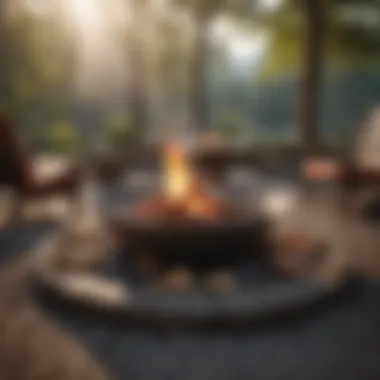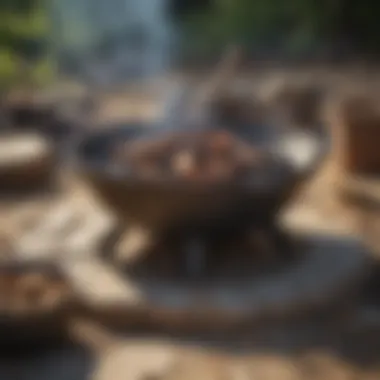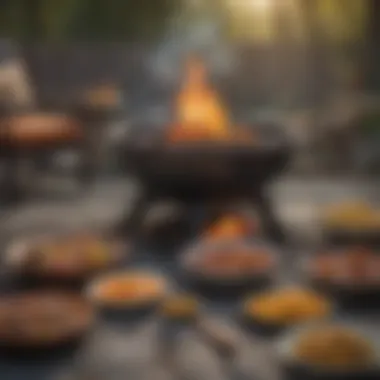Mastering Firepit Cooking: Techniques and Tips


Intro
Cooking on a firepit is a fundamental technique that transcends time and space. This method harkens back to ancient culinary practices, allowing people to connect with food in a distinct way. Firepits provide not just heat, but also flavor and ambiance, making them a popular choice for outdoor gatherings.
The art of firepit cooking involves multiple factors, from choosing the right equipment to selecting appropriate ingredients. Understanding these aspects adds depth to the cooking experience. More than just preparing food, it allows for participation in a communal ritual that many find satisfying.
As modern homeowners seek to recreate the culinary traditions of the past, it is essential to grasp the intricacies of firepit cooking. This guide will cover pressing techniques, challenges, solutions, and detailed step-by-step instructions to elevate your outdoor cooking skills. In doing so, it emphasizes the significance of safety considerations and adequate planning as critical pillars of successful firepit cooking.
Preface to Firepit Cooking
Cooking on a firepit has historical significance and practical benefits that resonate with today's culinary pursuits. The act of preparing food over an open flame connects us to ancient practices, evoking a sense of tradition and community. It represents a form of cooking that is both straightforward and deeply rooted in human history.
One of the key advantages of firepit cooking is its ability to develop rich flavor profiles, specifically through the use of smoke and char. The method allows for a variety of cooking styles, from grilling to baking, making it versatile. This adaptability caters to diverse tastes, ensuring there's something for everyone.
Moreover, cooking on a firepit fosters a unique social interaction. It creates a gathering spot for family and friends, transforming meals into experiences. Gathering around the firepit invites conversation and connection, which can enhance the overall enjoyment of food.
In summary, the introduction of firepit cooking sets the stage for an exploration of techniques and considerations that will enrich not only the culinary skills but also the shared experiences of those who participate in this time-honored tradition.
Historical Context
The origins of cooking over an open flame date back to prehistoric times. Early humans discovered that fire could be used not only for warmth but also for cooking. This discovery fundamentally altered diet and food preparation methods, paving the way for complex societies. The practice has evolved over millennia, adapting to geographical and cultural differences.
In many cultures, cooking with fire has a sacred component. It signifies sustenance and often plays a role in rituals and celebrations. From communal feasts to family gatherings, the firepit has been a focal point, bringing people together and fostering bonds.
Modern Resurgence
In recent years, there has been a renewed interest in firepit cooking among households. This resurgence is partly attributed to the growing trend of outdoor living spaces. Homeowners invest in firepits not only as a source of heat but also as a cooking apparatus that enhances their outdoor experience.
Technology has also shifted the perception of firepit cooking. Modern designs cater to the needs of contemporary cooks, providing versatility and ease of use. This makes the art of cooking over flames accessible to a broader audience, encouraging experimentation and creativity.
Additionally, there is a rising focus on sustainability and sourcing local ingredients. Firepit cooking aligns with these values, allowing individuals to embrace a more rustic and organic approach to food preparation. Hence, the current trend demonstrates an appreciation not just for the food itself, but for the entire process and its connection to nature.
Essential Equipment for Firepit Cooking
Cooking on a firepit requires careful consideration of essential equipment. The right tools not only enhance the cooking process but also ensure safety and efficiency. Selecting appropriate equipment involves understanding both functionality and safety implications.
Choosing the Right Firepit
The primary step in firepit cooking is choosing the right firepit for your needs. Firepits range from simple, portable designs to more elaborate built-in structures. When selecting, consider factors like size, material, and fuel type. A steel firepit is durable and retains heat well, while stone options provide a more aesthetic appeal.
Size is also crucial. A larger firepit can accommodate more food, making it ideal for gatherings. However, consider the space available in your backyard or patio. Also, if you intend to move your firepit around, portability becomes an important factor.
Safety features are another priority. Ensure that the firepit has adequate ventilation to prevent smoke buildup and is positioned away from flammable structures. It is wise to look for models with spark guards or screens to keep hot embers contained. Always read reviews and research brands like Solo Stove or Landmann to get insights on quality and performance.
Utensils and Accessories
Investing in the right utensils and accessories is essential for effective firepit cooking. The basics include long-handled spatulas, tongs, and grilling forks. Long handles are particularly valuable when working over open flames as they help maintain distance from heat and prevent burns.
Consider specialized accessories such as grill baskets for vegetables and skewers for kabobs. These items allow for cooking a variety of foods without them falling through the grates. Another valuable tool is a firepit cover, which protects your equipment from the elements and prolongs its lifespan. Don’t forget about thermometers to ensure your food is cooked to the perfect temperature.
Safety Gear


Safety gear is a critical component often overlooked by beginner firepit cooks. Proper gear minimizes the risk of accidents during cooking. A pair of heat-resistant gloves is essential for handling hot pots or adjusting the fire. These gloves should be made of materials that withstand high temperatures without melting.
Another important item is safety goggles or eyewear to protect your eyes from sparks. Comfortable, closed-toe footwear is advised when cooking near a fire, as it protects your feet in case of falling embers or hot coals. Utilizing a fire extinguisher nearby can also provide peace of mind during the cooking process, ensuring you are prepared for any emergency.
"The right equipment and gear can make the difference between a pleasant cooking experience and a hazardous situation. It is essential to prioritize safety alongside enjoyment in firepit cooking."
Selecting Fuel Sources
The choice of fuel is a pivotal aspect of firepit cooking. It directly impacts not only the heat produced but also the flavor imparted to the food. Choosing the right fuel enhances the overall cooking experience and ensures that the flavor profiles are maximized. Understanding different fuel sources helps in making informed decisions to cater to individual cooking preferences and techniques. This section aims to delve into two primary categories of fuel: wood and alternative fuels.
Types of Wood
Wood is the most common fuel source for firepits. Different types of wood produce varying aromas, flavors, and heat levels. When selecting wood for cooking, it is essential to consider its properties. Some woods are better for grilling, while others are more suitable for smoking. Here are some popular types of wood:
- Hickory: Known for its strong flavor, hickory is ideal for meats, particularly pork and ribs. It provides a rich, smoky taste that complements a wide variety of dishes.
- Mesquite: This wood burns hot and fast, imparting a robust, earthy flavor. It's particularly popular in Texas-style barbecue but may overwhelm lighter foods.
- Applewood: A milder option, applewood gives off a subtle sweetness. It is great for poultry, fish, and even some vegetables.
- Cherry: Similar to apple, cherry wood offers a sweet flavor. It also provides a beautiful color to foods, making it visually appealing.
- Oak: A versatile wood that burns steadily, oak contributes a mild flavor suitable for all types of meats and even some vegetables.
Choosing the right wood can be detrimental to the cooking results. Ensure the wood is dry and seasoned, as wet wood produces more smoke and less heat.
Alternative Fuels
Alternative fuels are becoming increasingly popular in firepit cooking due to their convenience and unique properties. Using charcoal or propane may simplify the process, particularly for those pressed for time. Here's a look at some alternative fuels:
- Charcoal: This is a widely used fuel, famous for grilling. Charcoal burns hotter than wood and maintains steady temperatures, making it excellent for direct high-heat cooking.
- Propane: This fuel source is often found in gas firepits. It heats quickly and offers precise temperature control, allowing for consistent cooking.
- Pellets: Made from compressed wood sawdust, pellet fuels are available in various wood flavors, such as mesquite and oak. They provide the benefit of both wood flavor and the ease of use similar to charcoal.
When selecting alternative fuels, consider factors such as availability, how much time you have for cooking, and the flavor you wish to achieve. Both wood and alternative fuels hold unique benefits, making a clear understanding of each essential for a successful cooking experience.
Preparing Ingredients for Firepit Cooking
Preparing ingredients is crucial for successful firepit cooking. The flavors developed from cooking over an open fire are distinct and can transform a regular meal into an extraordinary experience. This section discusses the importance of selecting the right ingredients, seasoning techniques, and how these elements can elevate your firepit cooking.
Marination Techniques
Marination serves as a foundational technique in enhancing the flavor of proteins before they meet the fire. A well-marinated protein not only absorbs the seasonings well but can also become more tender. The key to a successful marinade lies in balancing acid, fat, and seasoning. For instance, using yogurt or vinegar as a base helps in breaking down the proteins, making them more succulent. Consider these tips for effective marination:
- Timing: Marinate proteins for at least 30 minutes, but for tougher cuts, extend the time to several hours or overnight.
- Ingredients: Explore diverse combinations such as olive oil, herbs, garlic, and citrus juices.
"The essence of cooking is the delicate blend of flavors, particularly in firepit cooking where each element enhances the others."
Keep in mind that marination does not permit the use of overly aggressive flavors that might overshadow the natural essence of the ingredient itself. Thus, a careful approach to seasoning brings out the best results.
Choosing Vegetables and Proteins
When selecting vegetables and proteins for firepit cooking, consider both flavor and cooking times. Vegetables such as bell peppers, zucchini, and mushrooms hold up well to direct heat and offer a variety of textures. For proteins, chicken, shrimp, and various cuts of beef and pork are popular choices.
Here are some recommendations for selecting ingredients:
- Seasonal Produce: Using seasonal vegetables enhances freshness and flavor. During summer, for instance, tomatoes and corn can add sweetness to grilled dishes.
- Cut Size: Cut vegetables and proteins into uniform sizes to ensure even cooking. This minimizes the risk of some pieces being overcooked while others remain raw.
- Protein Selection: Opt for high-quality cuts if grilling. Grass-fed beef, organic chicken, and sustainably sourced seafood contribute not just to flavor but also to health.
Inclusion of fresh herbs and spices can further enhance your dish. A combination of rosemary, thyme, or basil will complement many grilled preparations. Remember to think about how these ingredients interact when they are cooked, as some flavors work well with one another while others do not.
Cooking Techniques on a Firepit
Cooking on a firepit involves several techniques that can enhance the overall culinary experience. Each method brings its own character to the food, offering unique flavors and textures. Understanding these techniques is crucial for anyone interested in mastering firepit cooking. It allows you to get the most out of the ingredients while making the process enjoyable and efficient.
Grilling
Grilling over an open flame is one of the most straightforward methods of cooking on a firepit. This technique involves placing food directly above the flames, often on a grill grate. The intense heat caramelizes the exterior, creating a savory crust while locking in moisture. Grilling is versatile; you can use it for meats, vegetables, and even some fruits. Choosing high-quality cuts of meat can make a significant difference. For example, steak and chicken thighs respond well to grilling.


When grilling, attention must be paid to the distance between the food and the flames. Adjusting the height of the grill can help manage the cooking temperature. A quick tip: Let your meat rest after cooking. This step allows the juices to redistribute, resulting in a more flavorful dish.
Skewering
Skewering is another engaging technique for cooking on a firepit. This method involves threading ingredients onto metal or wooden skewers. The act of skewering can elevate your presentation, making it visually appealing. Skewered food cooks evenly and allows for the incorporation of various ingredients.
Using a combination of proteins and vegetables is common. For instance, chicken paired with bell peppers and cherry tomatoes creates a colorful skewer. When using wooden skewers, it’s essential to soak them in water beforehand. This practice prevents them from burning during the cooking process. Like grilling, watching the cooking time is vital to avoid overcooking. Skewered dishes can cook quickly, especially with the high heat of an open flame.
Baking in a Dutch Oven
Baking in a Dutch oven is a technique that brings a different dimension to firepit cooking. This method involves using a heavy, cast-iron pot with a lid, which retains heat effectively. Placing the Dutch oven in or over the fire creates an oven-like environment.
This technique is perfect for stews, bread, or even casseroles. You can explore many recipes that adapt well to this method. When baking in a Dutch oven, preheating the pot is crucial. Carefully monitoring the temperature is also important. You can surround the pot with burning coals for even heat distribution. Furthermore, lifting the lid too often can let heat escape, so try to resist the urge.
"Mastering these cooking techniques enhances not only flavors but also the enjoyment of the firepit experience."
Flavor Profiles Developed by Fire Cooking
Cooking on a firepit offers a unique sensory experience that significantly enhances food flavor profiles. The interplay between direct flames, wood smoke, and heat develops complex tastes often unattainable with standard cooking techniques. This section explores two important elements that contribute to these flavor profiles: the impact of smoke and the enhancement of texture. Each element plays a crucial role in shaping the overall taste experience, and understanding these can elevate one’s cooking methods.
The Impact of Smoke
Smoke has a profound influence on the taste of food cooked over an open flame. It becomes an essential aspect of flavor development through various compounds released during combustion. The type of wood used can dramatically alter the result. For example, cooking with hickory imparts a strong, earthy tone, while applewood offers a sweeter, fruitier profile.
Besides variety, the timing and technique of exposing food to smoke will affect flavor depth. Adding smoking chips or using specific wood in chunks can create a distinct environment for the food. As the smoke permeates the meat or vegetables, it interacts with the natural fats, proteins, and sugars present, leading to a more robust taste.
In firepit cooking, it is essential to control smoke intensity. Too much smoke can overwhelm, while too little can lead to bland results. Below are a few considerations:
- Wood type: Experiment with different types for varied flavors.
- Soaking chips: Dry wood can burn too quickly. Soaking it helps maintain smoke over an extended period.
- Testing smoke levels: Be mindful of how long to expose your food to smoke to achieve the desired flavor without overpowering it.
"The careful selection of wood and control of smoking time can create layers of flavor, turning a simple meal into a culinary highlight."
Enhancing Texture
The texture of the food also shifts when cooked over a firepit. The high heat from flames produces a crisp exterior while the inside can remain tender and juicy. This contrast is vital in many culinary traditions.
When considering texture, think about these factors:
- Direct vs. indirect heat: Cooking close to flames produces char. Using back-end heat retains moisture.
- Marination: Marinades with acidic ingredients can tenderize proteins while contributing flavor. This practice is essential when cooking meats.
- Cooking method: Grilling creates a different texture than skewering or baking in a Dutch oven. Each technique offers unique interplay between fire and food.
Understanding how fire alters texture leads to more controlled and enjoyable cooking experiences. Many housewives and house owners can emphasize the importance of combining techniques. This understanding enriches meals beyond basic expectations, presenting a delightful mix between flavor and texture.
Safety Considerations in Firepit Cooking
The significance of safety in firepit cooking cannot be overstated. As appealing as the prospect of cooking over an open flame is, it comes with inherent risks. This section aims to highlight essential safety considerations that can enhance your outdoor cooking experience while minimizing hazards. Both seasoned cooks and novices need to understand these protocols to ensure their safety, as well as the safety of others.
Fire Safety Protocols
Prioritizing fire safety goes beyond just being cautious; it involves adhering to specific protocols that can prevent accidents. Here are some essential fire safety practices to consider:
- Choose a Safe Location: The firepit should be situated away from flammable materials, like overhanging branches or wooden structures. A clear area extending at least ten feet around the pit is ideal.
- Use Appropriate Fuel: Only use recommended fuels such as seasoned wood, charcoal, or specified firepit pellets. Utilizing inappropriate materials can release toxic fumes and create excessive smoke.
- Contain the Fire: Always maintain the fire within the designated firepit. Use a fire ring or barrier to prevent embers from escaping. If the firepit includes a lid, use it when not actively cooking on the fire.
- Keep Fire Extinguishing Tools Handy: Have a garden hose or a bucket of sand or water nearby to extinguish the fire quickly if necessary. It is prudent to also have a shovel available to help smother a fire.
- Never Leave the Fire Unattended: A fire should always be monitored. If you need to leave, ensure the fire is fully extinguished before doing so. This simple habit can save lives and property.
Incorporating these protocols into your firepit cooking routine can significantly enhance safety and prevent mishaps.


Food Safety Guidelines
Food safety in firepit cooking includes multiple considerations that ensure the wellbeing of all diners. Correct handling and cooking of foods can reduce the risk of foodborne illnesses. Here are notable guidelines to follow:
- Wash Your Hands: Before handling food, always wash your hands with soap and water, especially after touching raw meats or using fuel.
- Use Separate Utensils: To prevent cross-contamination, designate different utensils for raw and cooked foods. This will help keep your meal prep area safe.
- Check Food Temperatures: Equip yourself with a food thermometer and ensure meats reach the safe cooking temperature to eliminate harmful bacteria. Poultry should be cooked to 165°F, while ground meats should reach 160°F.
- Keep Foods Covered: Protecting food from insects and environmental contaminants is crucial. Utilize lids, foil, or covers to keep your ingredients safe before and after cooking.
- Store Leftovers Properly: After your cooking session, refrigerate any leftover food promptly to minimize the risk of spoilage and bacteria growth. Food should be stored in airtight containers and consumed within three to four days.
Adhering to these food safety guidelines will enhance the overall firepit cooking experience while ensuring that everyone remains healthy and safe.
"Safety is not just a priority, it's a responsibility that we owe to ourselves and our loved ones in every cooking endeavor."
By understanding and implementing these safety considerations, you create an enjoyable and secure environment for firepit cooking.
Cleanup and Maintenance of Firepits
Effective cleanup and maintenance of firepits is essential for long-term usability and safety. Neglecting this aspect can lead to improper burning conditions or even hazards. Well-maintained firepits not only contribute to safety but also enhance the overall cooking experience. Regular upkeep ensures that the firepit remains functional and aesthetically pleasing, making it an enjoyable centerpiece for outdoor gatherings.
Proper Disposal of Ashes
Proper disposal of ashes is a critical step in firepit maintenance. After cooking, ashes can accumulate, blocking airflow and affecting future cooking efficiency.
Here are the key considerations:
- Cooling the Ashes: Always allow ashes to cool completely before disposal. This process can take up to 24 hours.
- Using a Metal Container: Store cooled ashes in a metal container with a tight-fitting lid. This prevents any risk of spontaneous combustion.
- Recycling Ashes: Consider using the ashes in your garden. They can provide nutrients to soil. Add them in moderation to avoid imbalance in soil composition.
Proper disposal practices not only enhance the safety of your firepit but can also enrich your garden, showcasing a wonderful balance between functionality and sustainability.
Maintaining the Firepit
Regular maintenance of the firepit is vital to extend its lifespan and ensure safety during use. Here are vital maintenance practices:
- Cleaning: Clean the firepit regularly to remove soot and debris. This helps in maintaining proper airflow and efficient burning.
- Inspecting for Damage: Periodically check for cracks or rust. Early detection can prevent larger issues.
- Seasonal Protection: If the firepit is not in use for an extended period, consider covering it to protect against weather damage. This can also prevent rust.
- Reviewing Accessories: Assess and replace any worn-out accessories, like grates and utensils, that may degrade cooking performance.
- Wood Storage: Store firewood in a dry place. This keeps it ready for use and prevents moisture buildup, which can cause mold or rot.
Maintaining your firepit not only enhances its performance but also assures a safe cooking environment. Following these steps diligently results in an enjoyable and productive outdoor cooking experience.
Epilogue on Firepit Cooking
Firepit cooking is an art form that combines tradition with modern aesthetics. This section highlights the relevance of firepit cooking, encapsulating the essence of the practices discussed in the article. Cooking over an open flame offers unique flavors and textures that are hard to replicate with standard cooking methods. This can enhance both the food and the experience of those participating in the meal preparation.
The significance of firepit cooking lies not just in the food itself, but in the communal activity it creates. Gathering around a fire encourages interaction, fostering bonds among family and friends. This social aspect is equally crucial, making each meal more than just sustenance.
In addition, the article examines various techniques and considerations that contribute to a successful firepit cooking experience. From selecting the right equipment and fuel sources to understanding safety measures, each element is essential. These facets ensure that cooking on a firepit remains enjoyable and safe.
"Understanding firepit cooking empowers people to connect with nature and each other, making meals more meaningful."
The knowledge shared here aims to equip readers with the tools they need for a fulfilling firepit cooking experience. The takeaway should emphasize that careful planning and consideration can significantly elevate the quality of both the food and the cooking experience itself.
Summarization of Key Points
- Historical Importance: Firepit cooking has deep roots in human history. It represents a fundamental method of preparing food that dates back centuries.
- Essential Skills: Mastering cooking techniques such as grilling, skewering, and Dutch oven baking enhances the variety of meals.
- Safety Measures: Prioritizing fire safety and food safety minimizes risks and ensures a pleasant experience.
- Flavor Development: Cooking over an open flame encapsulates unique flavors, particularly from smoke, which cannot be achieved through other cooking methods.
- Cleaning and Maintenance: Proper care of your firepit extends its lifespan and ensures a safe cooking environment.
Future of Outdoor Cooking Techniques
The future of firepit cooking holds exciting potential for innovations in both equipment and techniques. Increasingly, homeowners are investing in versatile firepit designs that can serve multiple cooking purposes, such as grilling and smoking. Advancements in material technology mean that firepits are becoming more efficient and easier to use.
Furthermore, as culinary experiences evolve, there is a growing trend towards outdoor cooking classes focused on firepit methods. These workshops provide hands-on experience, teaching participants not only the culinary techniques but also the traditions that underpin them.
With a renewed interest in sustainable cooking, many are turning to locally sourced wood and organic ingredients. This shift may influence future cooking practices, promoting an emphasis on health and environmental safety.
The informal nature of firepit cooking also aligns well with the current culture of casual dining experiences rooted in community and shared enjoyment. As more families embrace outdoor cooking, the techniques discussed in this article can provide a backdrop for cultivating these new traditions.







